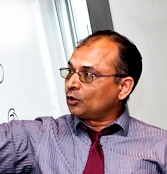PROJECT: Fracture mechanics of brittle matrix composites
SPONSOR - Air Force Office of Scientific Research, Washington
DC
PRINCIPAL INVESTIGATORS: Autar K. Kaw and Glen H. Besterfield
DATES: September 1992 - June 1995
Description:
A basic study of the fracture mechanics of brittle matrix
composites is proposed. Three analytical models for studying the
fracture mechanics of brittle matrix composites will be developed.
The solution will be based on two dimensional planar or three
dimensional axisymmetric conditions, linear elasticity and
imperfect fiber-matrix interface conditions.
1) The first model will determine the effect of finite fiber volume
fraction on the initiation of matrix cracking and damage mechanics
of brittle matrix composites.
2) The second model is a basic comparative study of the results and
conclusions drawn from solving fracture mechanics problems, such as
concerning stress at which matrix cracks initiate and deflection of
cracks at the interface, by using the planar and axisymmetric
assumptions.
3) The third model will find the effect of imperfections in the
interface in brittle matrix composites. The main emphasis will be
to calculate the damage zones in the fiber-matrix interface and
study its effect on the matrix crack initiation stress and the
crack deflection criteria.
All the above models will be compared with other analytical
models and experimental results available in the literature. On a
parametric basis, the fracture and damage mechanics of a matrix
crack will be studied as a function of the elastic moduli and the
thermal expansion coefficients of the constituents, fiber volume
fraction, operating temperatures, crack geometry, remote loading
strains, and roughness of the interface.
|
